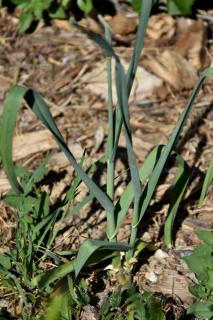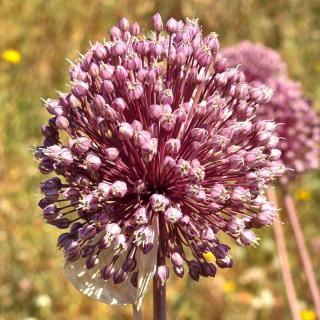

Perennial leek sprouts anew from its bulbs year after year.
Perennial leek key facts:
Botanical name – Allium polyanthum
Common names – Wild leek, perennial leek, many-flowered garlic
Family – Alliaceae
Type – Perennial vegetable
Height – 1 foot (30cm)
Exposure – Sun to part shade
Soil – any type, cool but well-draining
Planting distance – 12 to 16 inches (30 to 40 cm)
Sowing: spring or fall – Harvest: early fall → end of spring.
This is a species of leek that grows in the wild but can be cultivated. Much less famous than its cousin, domesticated leek, perennial leek has the advantage of growing back on its own every year. It doesn’t require much time to grow and plant, too. Here, you’ll discover all about this perennial vegetable and its delicious, soft shoots.
Perennial leek favors sun, but also does fine in only part sun. Moreover, since it doesn’t really care what type of soil it grows in, there isn’t anything special to do upon planting. It truly deserves a spot in your vegetable patch!
There are two ways of planting this particular Allium: splitting offshoots which are side bulbs that appear near the main stem, and simply purchasing it in stores where it often comes in nursery pots.

This technique is possible all year round, except for Summer and those days in Winter when the ground is frozen up. Open up the clump, gently teasing it apart so you don’t tear any roots, and place it in a hole about 4 to 6 inches deep (10 to 15 cm). Backfill the hole and press the soil tightly around the bulbs. Planting distance is the same as above, a bit under one foot (25 cm).

After a few years, you’ll notice stems grow thinner. This means you need to rejuvenate the bulbs if you want to keep harvests at a reasonable level. To do so, pull the bulbs out and separate all the offshoots, which you can plant back into the ground as described above. The best timing for this is during the dormant phase. For this vegetable, it comes at an unusual time: the middle of Summer.
Luckily, unlike its domesticated cousins, wild leek isn’t an interesting host for leek moth. However, it is sometimes targeted by the allium leaf miner. The only way to protect against this foe is to wrap a net around your crops. It may also help to sow carrot in alternate rows.
The harvest season for wild leek extents from the beginning of Fall to the end of Spring.
If you’ve planted offshoots, the first harvest can take place after 10 weeks. It takes longer for specimens planted from nursery pots since they require 3 to 6 months. Generally, only harvest once you feel the many-flowered garlics are properly settled in.
After this time when harvest is possible, the plant enters dormancy: leaves turn yellow and dry up, disappearing as time passes.
To harvest, you shouldn’t pull the bulb out. Simply remove mulch and soil around the base of the stem, and cut it off cleanly just above the bulb. Ideally, you would only collect what you need for the next few days. The base will sprout new leaves from its center that you can harvest again 2-3 months later.
If ever you’ve picked too many, place your stems in the refrigerator where they’ll keep for a good 10 days. To savor its delicious taste during summer, you can also freeze the stems: slice them and blanch them in boiling water for an instant.
If you’re already familiar with annual leek, you won’t find perennial leek very difficult. You substitute it for any recipe that calls for regular leek: soup, cream chowder, raw with a dash of vinegar, in stews… no limits for this vegetable!
In Europe, perennial leek is often found in the wild growing in vineyards. Such findings are a great treat and ensure dinner will be tasty!
Any more ideas re perennial vegetables please? I have celery and a few runner beans but would love more. Thanks